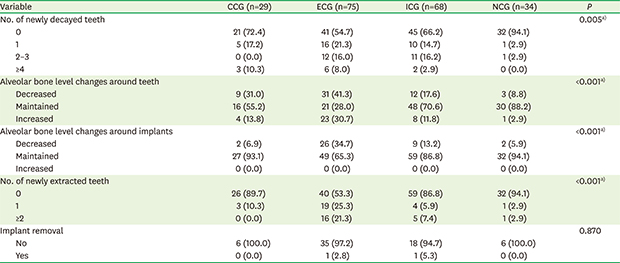1. Newman MG, Takei HH, Klokkevold PR, Carranza FA. Carranza's clinical periodontology. 11th ed. St. Louis (MO): Elsevier/Saunders;2012.
2. Gaurilcikaite E, Renton T, Grant AD. The paradox of painless periodontal disease. Oral Dis. 2017; 23:451–463.


3. Renvert S, Persson GR. Supportive periodontal therapy. Periodontol 2000. 2004; 36:179–195.


4. Agrawal N, Jain R, Jain M, Agarwal K, Dubey A. Compliance with supportive periodontal therapy among patients with aggressive and chronic periodontitis. J Oral Sci. 2015; 57:249–254.


5. Lang NP, Tonetti MS, Suter J, Sorrell J, Duff GW, Kornman KS. Effect of interleukin-1 gene polymorphisms on gingival inflammation assessed by bleeding on probing in a periodontal maintenance population. J Periodontal Res. 2000; 35:102–107.


6. Boström L, Linder LE, Bergström J. Influence of smoking on the outcome of periodontal surgery. A 5-year follow-up. J Clin Periodontol. 1998; 25:194–201.


7. Kocher T, König J, Dzierzon U, Sawaf H, Plagmann HC. Disease progression in periodontally treated and untreated patients--a retrospective study. J Clin Periodontol. 2000; 27:866–872.


8. Lee HW, Park JW, Suh JY, Lee JM. Patient compliance with supportive periodontal therapy. J Korean Acad Periodontol. 2009; 39:193–198.

9. Demetriou N, Tsami-Pandi A, Parashis A. Compliance with supportive periodontal treatment in private periodontal practice. A 14-year retrospective study. J Periodontol. 1995; 66:145–149.


10. Demirel K, Efeodlu A. Retrospective evaluation of patient compliance with supportive periodontal treatment. J Nihon Univ Sch Dent. 1995; 37:131–137.


11. Novaes AB Jr, Novaes AB. Compliance with supportive periodontal therapy. Part 1. Risk of non-compliance in the first 5-year period. J Periodontol. 1999; 70:679–682.


12. Mendoza AR, Newcomb GM, Nixon KC. Compliance with supportive periodontal therapy. J Periodontol. 1991; 62:731–736.


13. Kim YI, Heo HY. A analysis on the patient's awareness of periodontal diseases. J Korean Acad Dent Hyg Educ. 2008; 8:107–114.
14. Lee YS, Yun CY, Kim SM, Kim BO, Han KY. Investigation of age and treatment modalities in the periodontally treated(1981–1995) patients. J Korean Acad Periodontol. 2001; 31:225–231.

15. Kim JH, Chung HJ. The comparison of c linical changes during maintenance phase after non-surgical or surgical therapy of chronic periodontitis. J Korean Acad Periodontol. 2006; 36:69–84.

16. Park WK, Lee JK, Chang BS, Um HS. A retrospective study on patients' compliance with supportive periodontal therapy. J Korean Acad Periodontol. 2009; 39:59–70.

17. Ojima M, Hanioka T, Shizukuishi S. Survival analysis for degree of compliance with supportive periodontal therapy. J Clin Periodontol. 2001; 28:1091–1095.


18. Hausmann E, Allen K, Carpio L, Christersson LA, Clerehugh V. Computerized methodology for detection of alveolar crestal bone loss from serial intraoral radiographs. J Periodontol. 1992; 63:657–662.


19. Serino G, Turri A. Outcome of surgical treatment of peri-implantitis: results from a 2-year prospective clinical study in humans. Clin Oral Implants Res. 2011; 22:1214–1220.


20. Heitz-Mayfield LJ, Salvi GE, Mombelli A, Loup PJ, Heitz F, Kruger E, et al. Supportive peri-implant therapy following anti-infective surgical peri-implantitis treatment: 5-year survival and success. Clin Oral Implants Res. 2018; 29:1–6.


21. Page RC, Schroeder HE. Pathogenesis of inflammatory periodontal disease. A summary of current work. Lab Invest. 1976; 34:235–249.

22. Page RC, Kornman KS. The pathogenesis of human periodontitis: an introduction. Periodontol 2000. 1997; 14:9–11.


23. Ramfjord SP, Morrison EC, Burgett FG, Nissle RR, Shick RA, Zann GJ, et al. Oral hygiene and maintenance of periodontal support. J Periodontol. 1982; 53:26–30.


24. Knowles JW. Oral hygiene related to long-term effects of periodontal therapy. J Mich Dent Assoc. 1973; 55:147–150.

25. Lindhe J, Lang NP, Berglundh T, Giannobile WV, Sanz M. Clinical periodontology and implant dentistry. 6th ed. Chichester: John Wiley and Sons, Inc.;2015.
26. Novaes AB Jr, de Lima FR, Novaes AB. Compliance with supportive periodontal therapy and its relation to the bleeding index. J Periodontol. 1996; 67:976–980.


27. Kang H, Yoon Y, Park J, Sung M, Bae G, Kim J. Awareness of patients with periodontal disease under treatments at initial and maintenance phase. J Korean Acad Oral Health. 2005; 29:271–280.
28. Perrell-Jones C, Ireland RS. What factors influence patient compliance with supportive periodontal therapy in a general practice setting? Br Dent J. 2016; 221:701–704.

29. Heft MW, Meng X, Bradley MM, Lang PJ. Gender differences in reported dental fear and fear of dental pain. Community Dent Oral Epidemiol. 2007; 35:421–428.


30. Cardaropoli D, Gaveglio L. Supportive periodontal therapy and dental implants: an analysis of patients' compliance. Clin Oral Implants Res. 2012; 23:1385–1388.


31. Wilson TG Jr, Glover ME, Schoen J, Baus C, Jacobs T. Compliance with maintenance therapy in a private periodontal practice. J Periodontol. 1984; 55:468–473.


32. Frisch E, Ziebolz D, Vach K, Ratka-Krüger P. Supportive post-implant therapy: patient compliance rates and impacting factors: 3-year follow-up. J Clin Periodontol. 2014; 41:1007–1014.


33. Novaes AB, Novaes AB Jr, Moraes N, Campos GM, Grisi MF. Compliance with supportive periodontal therapy. J Periodontol. 1996; 67:213–216.


34. Matthews DC, Smith CG, Hanscom SL. Tooth loss in periodontal patients. J Can Dent Assoc. 2001; 67:207–210.
35. Sbordone L, Bortolaia C. Oral microbial biofilms and plaque-related diseases: microbial communities and their role in the shift from oral health to disease. Clin Oral Investig. 2003; 7:181–188.


36. Checchi L, Montevecchi M, Gatto MR, Trombelli L. Retrospective study of tooth loss in 92 treated periodontal patients. J Clin Periodontol. 2002; 29:651–656.


38. Lee CT, Huang HY, Sun TC, Karimbux N. Impact of patient compliance on tooth loss during supportive periodontal therapy: a systematic review and meta-analysis. J Dent Res. 2015; 94:777–786.


39. Tonetti MS, Steffen P, Muller-Campanile V, Suvan J, Lang NP. Initial extractions and tooth loss during supportive care in a periodontal population seeking comprehensive care. J Clin Periodontol. 2000; 27:824–831.


40. Cattabriga M, Rotundo R, Muzzi L, Nieri M, Verrocchi G, Cairo F, et al. Retrospective evaluation of the influence of the interleukin-1 genotype on radiographic bone levels in treated periodontal patients over 10 years. J Periodontol. 2001; 72:767–773.










 PDF
PDF ePub
ePub Citation
Citation Print
Print




 XML Download
XML Download